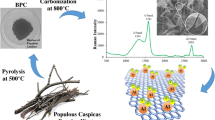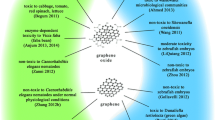Abstract
The applications of multilayered graphenes (MLGs), nanocomposites “MLG–decontaminant” and polydicarbonfluoride intercalation compounds for the localization and deactivation of toxic spills and gaseous emissions under technogenic accidents are investigated in this paper. The intercalation compounds contain oxidizers as intercalants, and MLGs are formed destructively by thermolysis of polydicarbonfluoride intercalation compounds. The sorptive capacity of MLGs (about 240 ml of liquid phase per 1 g of MLG) is much higher than in well-known expanded graphites (EGs) obtained from graphite oxide or graphite acid salts. Our investigation revealed the possibility of the production of the “MLG–decontaminant” nanocomposites with the neutralizator content >95% due to the extremely low (down to 0.4 g/l) apparent density of MLG and its high specific surface (about 370 m2/g). The use of these nanocomposites for the acid–base or redox neutralization of contaminants does not result in the overheating, sputtering or evaporation of liquid phases, because their neutralization products sorb into MLGs. It prevents the soil mineralization by liquid or solid deactivated spills. We revealed that polydicarbonfluoride intercalation compounds with oxidizers (ClF3, HNO3, N2O4) can be efficiently used for the deactivation of spills and gaseous emissions of nitrogen-containing base compounds.






Similar content being viewed by others
References
Adebajo MO, Frost RL, Kloprogge JT, Carmody O, Kokot S (2003) Porous materials for oil spill cleanup: a review of synthesis and absorbing properties. J Porous Mater 10:159–170
Carmody O, Frost R, Xi Y, Kokot S (2008) Selected adsorbent materials for oil spill cleanup. A Thermoanalytical Study J Therm Anal Calorim 91:809–816
Fadeeva VP, Nikonorov YI (1980) Analysis of certain fluorine-containing compounds of graphite. Izv Sib Otd Akad Nauk SSSR Ser Khim Nauk 12:101–104 (in Russian)
Fenelonov VB (1995) Porous Carbon. Boreskov Institute of Catalysis SB RAS, Novosibirsk, Russian Federation (in Russian)
Gammoun A, Tahiri S, Albizane A, Azzi M, Moros J, Garrigues S, de la Guardia M (2007) Separation of motor oils, oily wastes and hydrocarbons from contaminated water by sorption on chrome shavings. J Hazard Mater 145:148–153
Geim AK, Novoselov KS (2007) The rise of graphene. Nat Mater 6:183–191
Grayfer ED, Makotchenko VG, Kibis LS, Boronin AI, Pazhetnov EM, Zaikovskii VI, Fedorov VE (2013) Synthesis, properties, and dispersion of few-layer graphene fluoride. Chem Asian J 8:2015–2022
Koganovsky AM, Klimenko NA, Levchenko TM, Roda IG (1990) Adsorption of organic substances from water. Khimiya, Leningrad, USSR (in Russian)
Kruchinin NA (2005) Engineering ecology methods for potentially dangerous substances. SIP RIA, Moscow, Russian Federation (in Russian).
Makotchenko VG, Nazarov AS (2009) Structural characteristics of dicarbon polyfluoride. J Struct Chem 50:1088–1095
Makotchenko VG, Nazarov AS, Yur'ev GS, Yakovlev II (1991) Thermal stability of intercalation compounds of fluorinated graphite with organic liquids. Russ J Inorg Chem 36:1950–1954 (in Russian)
Makotchenko VG, Grayfer ED, Nazarov AS, Kim S-J, Fedorov VE (2011) The synthesis and properties of highly exfoliated graphites from fluorinated graphite intercalation compounds. Carbon 49:3233–3241
Makotchenko VG, Pinakov DV, Logvinenko VA (2015) The influence of dimensional effects on the composition and properties of polydicarbonfluoride. Chem Asian J 10:1761–1767
Mysore D, Viraraghavan T, Jin Y-C (2005) Treament of oily waters using vermiculite. Water Res 39:2643–2653
Nazarov AS, Antimonov AF (1980) Interaction of ammonia with fluorinated graphite compounds. Russ J Inorg Chem 25:2123–2128 (in Russian)
Samonin VV, Slutsker EM (2003) Adsorption properties of fullerene blacks. Russ J Phys Chem 77:1155–1159
Santos VP, Pereira MFR, Faria PCC, Órfão JJM (2009) Decolourisation of dye solutions by oxidation with H2O2 in the presence of modified activated carbons. J Hazard Mater 162:736–742
Sirotkina EE, Novoselova LY (2005) Materials for adsorptive purification of water from oil and petrochemicals. Chem Sustainable Dev 13:359–375
Smolyakov BS, Sagidullin AK, Bychkov AL, Lomovsky IO, Lomovsky OI (2015) Humic-modified natural and synthetic carbon adsorbents for the removal of Cd(II) from aqueous solutions. J Environ Chem Eng 3:1939–1946
Suni S, Kosunen A-L, Hautala M, Pasila A, Romantschuk M (2004) Use of a by-product of peat excavation, cotton grass fibre, as a sorbent for oil-spills. Mar Pollut Bull 49:916–921
Toyoda M, Inagaki M (2000) Heavy oil sorption using exfoliated graphite: new application of exfoliated graphite to protect heavy oil pollution. Carbon 38:199–210
Tryba B, Przepiórski J, Morawski AW (2002) Influence of chemically prepared H2SO4-graphite intercalation compound (GIC) precursor on parameters of exfoliated graphite (EG) for oil sorption from water. Carbon 41:2009–2025
Urazova TS, Bychkov AL, Lomovskii OI (2015) Sorption capacity of lignocellulosic materials toward humic acids. Russ Chem Bull 64:1183–1188
Wang G, Sun Q, Zhang Y, Fan J, Ma L (2010) Sorption and regeneration of magnetic exfoliated graphite as a new sorbent for oil pollution. Desalination 263:183–188
Wei QF, Mather RR, Fotheringham AF, Yang RD (2003) Evaluation of nonwoven polypropylene oil sorbents in marine oil-spill recovery. Mar Pollut Bull 46:780–783
Yadav BC, Kumar R (2008) Structure, properties and applications of fullerenes. International Journal of Nanotechnology and Applications 2:15–24
Zhao H, Zhou W, Shen W, Kang F 2007 Pore structure of exfoliated graphite and its varieties of liquid sorption. Abstracts of Int. Symp. on Intercalation Compounds ISIC-11. Kyiv (Ukraine); p. 28
Zheng Y-P, Kang F, Wang H-N (2007) Absorbing space of exfoliated graphite. Abstracts of Int. Symp. on Intercalation Compounds ISIC-11. Kyiv (Ukraine); p. 29.
Acknowledgements
This work was funded by the Russian Foundation for Basic Research (Grants No. 16-03-00048 and 16-29-06440). D.V. Pinakov thanks the Russian Science Foundation (Grant No. 14-13-00813) for the support of sorptive measurements.
Author information
Authors and Affiliations
Corresponding author
Additional information
Responsible editor: Santiago V. Luis
Rights and permissions
About this article
Cite this article
Makotchenko, V.G., Makotchenko, E.V. & Pinakov, D.V. The ways of use of multilayered graphene in engineering ecology. Environ Sci Pollut Res 24, 2402–2411 (2017). https://doi.org/10.1007/s11356-016-8019-9
Received:
Accepted:
Published:
Issue Date:
DOI: https://doi.org/10.1007/s11356-016-8019-9




